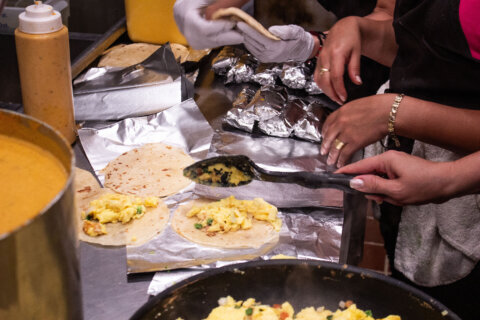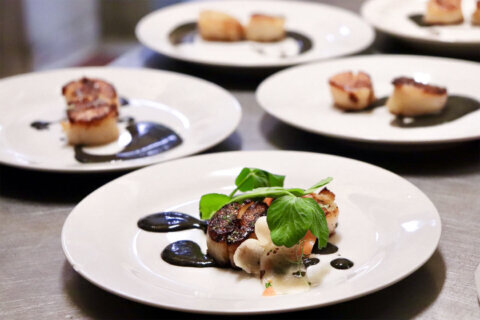With dishes like her Pekin Duck with Hakurei Turnips, Morello Cherry, Sumac & Labne, executive chef Mary Attea of The Musket Room in New York City has received tons of praise, and one coveted title: Michelin-starred chef.
“That’s something that’ll follow you around forever,” said Sanneh.
“If I think too much about it, it gets a little overwhelming,” Attea laughed. “But it is something that I’m really proud of.”
The Musket Room opened ten years ago. It was awarded a Michelin star in 2014, and every year since. Attea took over in the kitchen in 2020. She said, “I felt like I had some big shoes to fill to kind of maintain the standard that was here, but also impart my own vision on it.”
The Michelin Guide‘s restaurant reviewers (known as inspectors) took note in their review, writing, “Mary Frances Attea is the master and commander of this restaurant.”
Sanneh asked, “Is that the phrase you were expecting?”
“It wasn’t, but, you know, I’ll take it!”
The work of Camari Mick, the executive pastry chef, was recognized, too; Michelin called her desserts “thought-provoking.”
“I want it to have meaning and not just be random ingredients thrown together just because they sound cool,” Attea said. “There should be a little bit of a story behind it.”
Michelin, the French tire manufacturer, first published the Michelin Guide in 1900. It began awarding stars to restaurants in France about 100 years ago. “The founding brothers, frères Michelin, had this brilliant idea to have a guide to help the people travel,” said Gwendal Poullennec, the Michelin Guide’s international director.
Michelin still sells tires. But, said Poullennec, “The ones making the tires are not the professional anonymous inspectors eating out in the restaurants every day.”
Today, international teams of inspectors review restaurants in countries around the world, including the U.S., with guides in Washington, California, New York, Chicago, and (as of last year) Florida.
Sanneh asked, “So the idea is, while you’re driving around on our car tires, here are some places you might stop for a meal?”
“One star is worth a stop,” said Poullennec. “Two stars worth a detour, and three stars worth a special journey.”
Restaurants often brag about having a Michelin star (or two, or three). There are only about 140 three-star restaurants worldwide, 13 of them in the United States.
But the inspectors who award them are strictly anonymous.
“Sunday Morning” sat down with one, on the condition that we not reveal his name, or his face.
Sanneh asked, “What do your friends think you do for a living?”
“They know I’m still in the industry,” the inspector replied. “They just don’t know what I do exactly.”
He said he has experience in hotel dining and a degree from culinary school. He’s been a Michelin inspector for about 20 years. And in all that time, he said, he has never been made: “But I will say that, having worked in the industry for so long, I do run into people that I’ve worked with previously in restaurants.” He tells them he’s a “consultant.”
But sometimes, advanced spy craft is required, to keep that anonymity in this day and age. “We use aliases; we change them up routinely,” he said. “We use fake numbers.”
Sanneh quoted the Michelin review of Musket Room: “The ‘master and commander of this restaurant.’ Does that phrase sound familiar to you?”
“It does, it does, yes,” the inspector replied.
“So, are you allowed to reveal to us that you have eaten at Musket Room?”
“I have.”
“And what impressed you about the food there?”
“It has a personality, something that makes that dish quite unique or special,” he said.
Gwendal Poullennec said the guide is single-minded: “The star is only about the quality of the food; it’s not about the service and the setting.”
He said Michelin inspectors rate food based on specific criteria: “The quality of the products, the mastery of cooking techniques, the harmony and balance in flavors, the personality of the chef as expressed on the plate, and last but not least, the consistency both over time and throughout the menu as a whole.”
When reviewing a restaurant, inspectors may be sent in pairs or larger groups. “But they can also, of course, go alone,” Poullennec said. “The Michelin Guide decision and recommendation is never a one-man show, to ensure the quality and the worldwide consistency of a restaurant’s recommendations.”
Mary Attea says these stars are valuable: “Having a Michelin star maintains business,” she said. “People seek out restaurants with the honor. So, you know, we always try to keep an eye on anyone that might look like they’re inspecting a meal.”
Like many restaurants, the Musket Room keeps photos of influential critics on the kitchen wall. Michelin inspectors are harder to spot. They could be anyone, and they could be anywhere (or almost anywhere).
Sanneh asked Poullennec, “Have you eaten a hot dog from a cart?”
“Yes, I did,” he replied.
“How’d you like it?”
“I think that’s part of the New York experience as well,” Poullennec said.
“That sounds like a very polite, ‘No star for you.'”
Poullennec shrugged.







